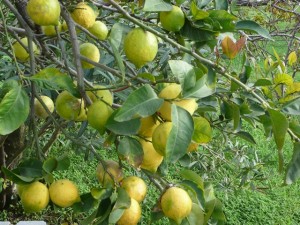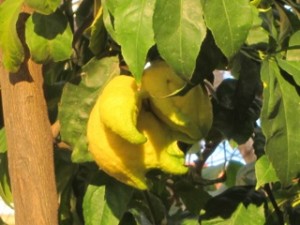Sweet & Sour—All About Lemons
Eating Well Is The Best Revenge
by Diana Farr Louis
 ATHENS, Greece—(Weekly Hubris)—1/17/10—Remember the old song, “Lemon tree very pretty and its flower is so sweet, but the fruit of the poor lemon is impossible to eat?”
ATHENS, Greece—(Weekly Hubris)—1/17/10—Remember the old song, “Lemon tree very pretty and its flower is so sweet, but the fruit of the poor lemon is impossible to eat?”
Well, with all due respect to Peter, Paul and Mary, it ain’t necessarily so.
For years I labored under the same delusion. The lemons I used to suck on as a child were sour indeed, though I loved nibbling on the rind and savoring the pulp. Usually after it had been soaking in a drink: first, ginger ale; later, gin and tonic.
Lemons as more than something to squeeze onto fish didn’t really enter my consciousness until I went to Greece. I had never even seen a lemon tree until those summers on Spetses back in the 60’s. My new family’s house there had a prolific albeit small lemon/fig grove, but picking figs for breakfast held much more appeal than citrus gathering, though their perfume was infinitely more seductive.

Instead of eating those lemons, we used to marvel at their incredible shapes. Some were Frankenstein fruit, with three points curved like claws or beaks, monstrous protuberant nipples, and nubbly skins. We would never slice those but kept them as curiosities until they shriveled. I’ve never seen so many deformations since. Was it the proximity of the figs that caused those mutants? Or something more sinister?
It wasn’t until I moved to Greece in ’72 and had to cook that I began to appreciate the value of fresh lemons. Back then our enchanted garden in Maroussi (no, the Colossus was already in Never-Never-Land by then) had two lemon trees (as well as figs, olives, apricots, and peaches), and it was such a treat to pick a couple whenever a recipe required.

And that was often. So many Greek dishes call for lots of lemon juice. All those soups thickened with egg and lemon. All those stuffed vine leaves, cabbage leaves, zukes, artichokes . . . swimming in sinful egg-lemon sauce. Braised chicken or lamb/kid “lemonato”; pork with celery, lamb frikasél; ladolemono (oil and lemon), a whipped emulsion for basting grilled fish and then ladling onto your plate to make the fish even tastier; a myriad vegetables either stewed or dressed with lemon.
I’m sure I’m leaving out half the repertoire and I haven’t even mentioned salads, but you get the idea.
Nevertheless, it was not until I went to Amalfi in the spring of 2002 that I discovered that lemons could be sweet.
I was part of an Oldways food safari (see “Remembering Dun Gifford”, 5/31/10) to Italy that began in Salerno and ended farther south in the less well known Cilento. During that week, we went to a water buffalo farm and tasted mozzarella di bufalo almost before it was cheese, had a pizza-making demo, talked to anchovy fishermen and agriturismo owners in delicious surroundings, and ate copiously and fabulously non-stop.
But our first excursion stands out in my mind. Both because it was a wash-out and because I learned so much.
Imagine going all that way to visit the Amalfi coast only to watch it from a streaming bus window as our oversize carrier inched along lanes made for donkeys. All I could see through the rain were almost vertical lush slopes that plummeted down to the sea, and emerald and yellow tiles glistening on the church domes in each village.
When we finally stopped, in Minori I think, we followed our leader to a pastry shop for a lesson in lemons. Our teacher, who had the euphonious name of Pasquale Salvatore, told us that lemons had been a pillar of the local economy for centuries, even though they grow on terraces carved out of the cliff sides, rather than the flat groves of the Argolid or Florida. Each plot, no longer or wider than our Pullman, has space for only four trees. Their roots keep the earth from sliding into the sea.
He maintained that they’ve been growing there since late Roman times, from seeds brought by Jewish slaves, who used the fruit to celebrate the harvest festival of Succoth. (But most scholars say that was a citron and that the true lemon arrived in the 11th century with the Arabs.) Whatever the case, the Scuola Medica di Salerno, the oldest university in Europe, listed a hundred uses for lemons. And for the seagoing empires of Genoa and Pisa, the lemons of Amalfi were worth their weight in gold; they appear to have realized their anti-scurvy properties long before the Limeys.
History slipped down as easily as the limoncello we were offered. Surprisingly, it’s not an ancient liqueur but rather a modern invention designed to please ladies, who may wish a touch of sweetness in their grappa. Listening to the recipe—which I’ll send to anyone who has access to organic, ultra-fresh lemons—I absorbed some fascinating trivia. For example, the locals grate the peel with the tool they use for scraping callouses from their feet, available at any farmacia. Luckily, it’s not indispensable. I also acquired a new phrase: “buccio d’arancio” or orange peel, or slang for cellulite. Very graphic, no?
Then we had a lemon-tasting session. Amalfi lemons, called sfusato, are shaped more like mini-footballs than tennis or golf balls. They are large and so sweet that the Amalfitans eat them sliced in salad dressed with garlic, mint, salt, and olive oil, fried along with small fish, or just sprinkled with a little sugar as a snack. Taking a bite did not pucker the lips in the least or set one’s teeth on edge.
But after all, we were in a pastry shop—Salvatore di Riso’s, if it’s still there—and so we were obliged to try the sweets: sfogliatella, a kind of strudel stuffed with ricotta, semolina, and lemon peel; delizia alla limone, sponge cake filled with lemon custard and fresh cream; dolce di Amalfi, a cake that includes almonds, lemon juice and grated zest, and limoncello; baba al limone (insteady of rum); and profiterolles with lemon sauce. The proprietor had baked for the Papal Jubilee and said making these sweets was a passion not a job.
We did them justice, and then went on to a sodden Ravello for a six-course lunch.
Back in Greece, I have to make do with ordinary lemons. But we are spoiled nevertheless. Every one we consume comes from our own trees. And they produce all year long. Phenomena, they sport tiny buds, green infants and adolescents, as well as juicy yellow globes even in summer—the low season for the fruit. And especially in winter and spring.
This means, however, that we are slaves to their prodigality, tyrannized by their output. Each time we return to Athens from the island, we ferry sacks-ful for ourselves and friends. Even though the freezer is stuffed with cubes of juice from last year. And they keep me busy thinking of up uses for them.
I haven’t yet looked at the medieval list from the Salerno Medical School, but I do make limoncello, chutney, marmalade, Moroccan lemons preserved with salt, and the occasional dessert, but not lemon curd—too many eggs.
Lemons, sweet or sour, I can’t live without them.
Here’s one of my favorite recipes using lemon juice. It’s from my Ionian cookbook, Prospero’s Kitchen, and was actually perfected by my co-author and friend, June Marinos.
Foolproof Egg-Lemon (Avgolemono) Soup
12 cups chicken, fish, or meat stock or soup
2 eggs, separated
juice of 2 lemons or more, to taste
salt and freshly ground black pepper
Remove the soup from the heat. In a large bowl beat the egg whites until fairly stiff; then beat the yolks in a separate bowl. Add the lemon juice very slowly to the yokes, beating constantly. Now stir this mixture slowly into the egg whites. Add two cups of broth to the egg-lemon bowl, still stirring. Pour this liquid, a little at a time, back into the remaining soup, stirring in one direction only. Season with salt and pepper and reheat the soup without allowing it boil. Don’t cover the pot or the soup may curdle, and don’t boil or you’ll have stracciatella or egg-drop/scrambled egg soup. It will taste OK but won’t look very appetizing.
Lately, I’ve taken to adding the grated zest of the lemons as well for extra flavor. This method makes the soup foamy and creamy at the same time.
5 Comments
chris louis
VERRRRY good! liked the bit with the gin tonic!
eboleman-herring
Went out, after reading this, to a friend’s Greek taverna here in Joisey. Rubbed lemon–as we do in Greece–all over my hands after eating pork chops. If I closed my eyes, I was almost, almost, back in the Cyclades.
Eben A.Knowlton
Dear Nancy
Just found an early written work by you in a 1948 issue of “Lawrence Life”
Ned Farr was kind enough to point me toward Greece. I was a contemporary of your brother, Tom,and we were good friends until we lost touch in 1979. My brother, Jon Knowlton, whom you may have known died afew years ago,
I see you are giving Julia Childs a real challenge .. well done!
Eben K
Eb Knowlton
As a child, I developed a taste for sugar and Angostura bitters. I leave the source to your imagination…..
dfff
far out. these lemons are hardcore